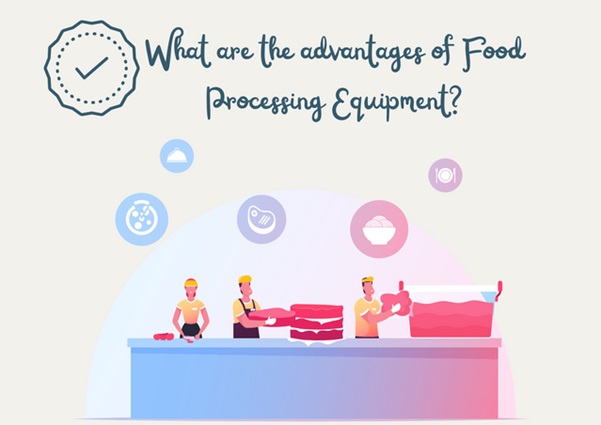In today’s world, food processing equipment has grown increasingly crucial. These machines are now made by a variety of manufacturers and widely available across the world. This type of industrial machine is also very specific in its function, basically to help in food preparations. Most are largely general-purpose devices, however, there are a few that are more specialised and found in factory settings.
What are the advantages of Food Processing Equipment?
In terms of manufacturing volume, a commercial food processor can make a significant impact. They’re similar to ones sold for personal use, but the size is obviously much larger, which entails that they are made to be heavy-duty. Ice makers and ovens are among the other items on this list. Drink preparation machine such as juicer, blender, and soft-serve machine (for floats) must also be included in this area because the public prefers to have their beverages readily available.
Because health departments must oversee the correct hygienic procedures for any form of food manufacturing, it is critical that all current standards be followed when you venture into this field. When the public’s health is in jeopardy, the equipment in use must meet a higher level of sanitation security. In order to comply with government regulations, food processing equipment is essential. It lessens the use of bare hands for preparations, thus, minimizing the risk for cross-contamination. Since the food prep is shortened, the breeding of bacteria will also be minimized.
Food processing machine can also do wonders in cutting your needed workforce, lessen your employees’ tasks, and make the food preparation process smoother and more efficient.
Types of Food Processing Equipment Based on Function
While the large range of food processing equipment available can be grouped and categorised in a variety of ways, including their end product, operating mode, function, and more, this article will conform to how they are classified in the market and groups them by their purposes.
When we talk about function in terms of food processing equipment, we can divide the group into the stages of food preparation. This is because, for every phase of the food preparation, there is a specific function a machine will perform. Therefore, we will classify the machines into preparations, mechanical, heating, preservation and packaging. We will go over each of the categories below:
Preparations
The initial preparation activities for food handling involves separating the desirable material from the poor quality, inferior, or undesired material in order to prepare the raw food material for the following processes. Manufacturers can ensure the creation of homogeneous and high-quality food products while also removing extraneous matter and pollutants that could degrade or damage the food in this stage of food preparation. Most of the machines involved in this stage are for skinning, peeling, seeding, washing, grounding, and chopping raw ingredients.
Mechanical
To cut, inflate, homogenize, or otherwise alter the existing form of solid, semi-solid, and liquid raw ingredients, mechanical processing equipment is used. Producers can facilitate and raise the efficiency and efficacy of succeeding procedures, improve overall quality and edibility, and allow for a wider range of food products by changing the form and size of the raw ingredients. Some common forms of machines use for mechanical preparations are grinder, blender, ice maker, meat cutter, mincer, soft-serve machine and more.
Heating Process
Generally, food is cooked either by heating or cooling. There are more dishes that are prepared through heating machines, however. Heat processing equipment can create chemical and biochemical changes in the ingredients in addition to physical changes. These alterations can modify the overall quality of the resulting food products. For example, by modifying the chemical composition of the food through cooking over the fire, the raw ingredients will have a boost in the flavour, as well as function as a preservation mechanism by suppressing or eliminating the spoilage bacteria. Thus, the many machines use for the heating process like stove, oven, torch, food warmer, and more are used to prevent food spoilage aside from changing the raw ingredients to be more edible.
Preservation
The preservation stage of the food processing production cycle attempts to prevent or reduce food spoilage and extend the shelf life of goods. There are a variety of preservation techniques available, ranging from refrigeration to the use of radiation technology, all of which act to kill bacteria and enzymes within the raw goods. When we talk about food preservation, we almost often think of freezing techniques like the use of a commercial fridge to preserve the raw ingredients in restaurants. However, there are various heating methods used to preserve the food. For example, smoking the meat, like those of processed ham and bacon.

All of these categories will be helpful to your food business should you decide to venture into one. Investing in these food preparation machines will ensure proper sanitation and will save you more due to lowering the risk of food wastage.
Where to buy your food preparation machines?
Food preservation machines are highly important in the efficiency and safety of your food business. Moreover, they are among the most expensive investments you’ll deal with in your food business. With that being said, you must always consider the quality of the food preparation machines you will purchase. While settling for cheaper ones can save you a lot in short term, the safety of your business, as well as the need for constant repair, must always be considered.
If you are looking for a reliable supplier of quality food preparation machines in Singapore, Simplex might be the dealer for you. We are an exclusive distributor of many popular international brands. Ours is a place where you can buy ovens, food warmers, fridge, various stoves, and a lot more. We also offer good warranties and promos to make our products more affordable for you. With Simplex, starting your food business is made simple.

.














